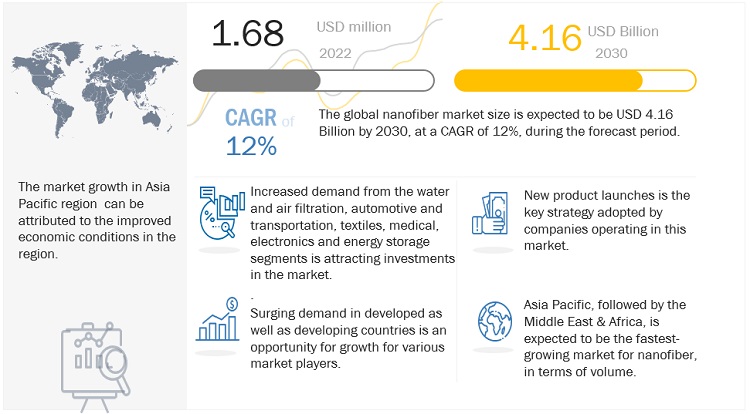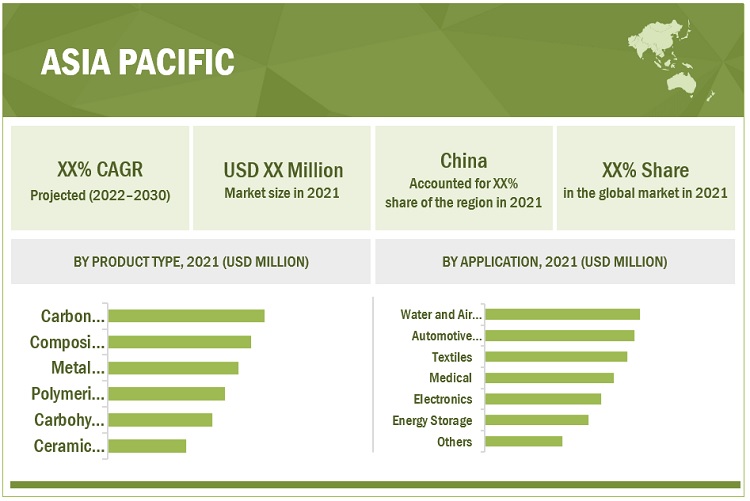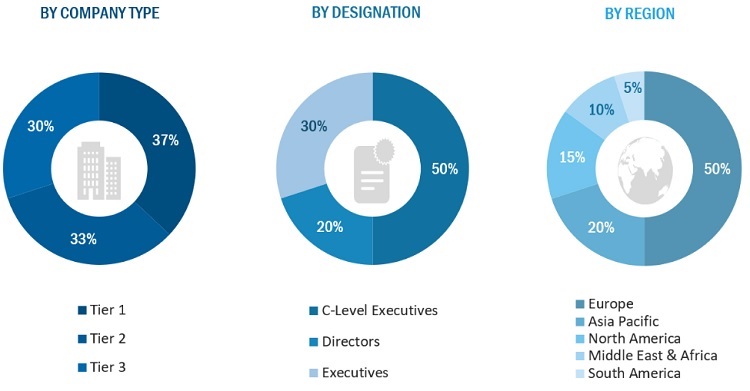Nanofiber Market by Product Type (Carbon Nanofiber, Composite Nanofiber, Metal and Metal Oxide Nanofiber, Polymeric Nanofiber, Carbohydrate based Nanofiber and Ceramic Nanofiber), Application (Water and Air Filtration, Automotive and Transportation, Textiles, Medical, Electronics, Energy Storage, and Other), and Region - Global Forecast to 2030
The nanofiber market is projected to reach USD 4.16 billion by 2030, at a CAGR of 12.0% from USD 1.68 million in 2022. One of the major factors contributing to the growth of the nanofiber market is the growing consumption of nanofiber in automotive, marine, and medical industries. Also, the rising demand for nanofibers for use in the production of air and water filters is also driving the market.
Attractive Opportunities in the Nanofiber Market

To know about the assumptions considered for the study, Request for Free Sample Report
Market Dynamics
Driver: Increased use of nanofibers in the electronics segment
Due to characteristics like chemical flexibility, low cost, and ease of manufacture, polymer nanofibers made by the electrospinning method have a great deal of potential for use in photonics and electronics. A variety of light-emitting sources, sensors, and energy harvesters use nanofiber as an active component. Nanofibers also find widespread use in organic semiconductors. Organic compounds that exhibit semiconducting qualities are known as organic semiconductors. These are inexpensive, effective, and lightweight. These nanofibers are produced at a low cost thanks to the production methods used.
Restraints: Manufacturing and non-recurring development costs
Manufacturing and non-recurring development costs continue to limit composites' penetration in a variety of applications, including sporting goods, marine, and consumer goods. The primary concerns are design consistency, process standardization, and maintenance technology. The lack of material and methodology standardization forces manufacturers to consider conservative designs, which impedes mass production and economic performance of automobiles and aircraft. Furthermore, limited human resources with composite training and experience limit the scope of composite applications. Nanofibers are used more frequently in organic semiconductors as well. Organic compounds that exhibit semiconducting qualities are known as organic semiconductors. These are inexpensive, effective, and lightweight. The techniques that are used to manufacture these nanofibers are quite inexpensive as well.
Opportunities: Increased hygiene standards among people
The general hygiene norms of people have increased considerably, more so after the covid-19 pandemic. People have now become aware of the necessity for clean and sanitized environment after witnessing the wrath of the pandemic. This is leading to the rise in demand of air and water filters wherein nanofibers are extensively used. The deterioration of air quality globally as a result of increasing pollution is also making people become more conscious about the indoor air quality which is driving the demand for air filters. The market in Asia-Pacific seems to be a lucrative one due to many factors such as enhanced standard of living, increased disposable income and rapid urbanization.
“Water and air filtration was the largest application for nanofiber market in 2021, in terms of value”
With their high surface-to-volume ratio, low pressure drops, superior void interconnectivity, and tunable connectivity and morphology, electro spun nanofiber-based filter media excel at outstanding filtration. Nanofibers are utilized in high-efficiency particulate air (HEPA) filters as a result of these reasons. Several chemical and gas sensing applications, including the detection of air quality, inspection of dangerous and flammable gases, and environmental monitoring, are actively being investigated with nanofibers made from metal oxide semiconductors. These nanofibers can quickly identify a variety of reducing and oxidizing gases.
“Asia-pacific was the largest market for nanofiber in 2021, in terms of value.”
The market has been expanding as a result of rising demand from sectors like healthcare, aerospace and military, energy, and automotive. After the US, China has the second-largest healthcare sector in the world. By 2030, China is anticipated to contribute around 25% of the income to the global healthcare sector. The need for nanofiber for drug delivery, tissue engineering, stem cell therapy, cancer therapy, and wound healing is anticipated to rise as a result.

To know about the assumptions considered for the study, download the pdf brochure
Key Market Players
The key players in this market are eSpin Technologies(US), Hollingsworth & Vose Company (US), Nippon Paper Industries Co., Ltd (Japan), Teijin Limited (Japan), and Toray Industries, Inc (Japan). Continuous developments in the market—including new product launches, mergers & acquisitions, agreements, and expansions—are expected to help the market grow. Leading manufacturers of nanofiber market have opted for new product launches to sustain their market position.

Want to explore hidden markets that can drive new revenue in Nanofiber Market?
 Scope of the Report
Scope of the Report

Want to explore hidden markets that can drive new revenue in Nanofiber Market?

|
Report Metric |
Details |
|
Years considered for the study |
2018-2030 |
|
Base Year |
2021 |
|
Forecast period |
2022–2030 |
|
Units considered |
Volume (Kilotons); Value (USD Billion) |
|
Segments |
Product Type, Application and Region |
|
Regions |
Asia Pacific, North America, Europe, Middle East & Africa, and Rest of the world |
|
Companies |
The key players in this market are eSpin Technologies Inc. (US), Hollingsworth & Vose Company (US), Nippon Paper Industries Co. Ltd (Japan), Teijin Limited (Japan), Toray Industries Inc (Japan). |
This report categorizes the global nanofiber market based on product type, application and region.
On the basis of product type, the nanofiber market has been segmented as follows:
- Carbon Nanofiber
- Composite Nanofiber
- Metal and Metal Oxide Nanofiber
- Polymeric Nanofiber
- Carbohydrate based Nanofiber
- Ceramic Nanofiber
On the basis of application, the nanofiber market has been segmented as follows:
- Water and Air Filtration
- Automotive and Transportation
- Textiles
- Medical
- Electronics
- Energy Storage
- Others
On the basis of region, the nanofiber market has been segmented as follows:
- Asia Pacific
- Europe
- North America
- Middle East & Africa
- Rest of the world
Frequently Asked Questions (FAQ):
What is the expected growth rate of nanofiber market?
The forecast period for nanofiber market in this study is 2022-2030. The nanofiber market is projected to grow at CAGR of 12%, in terms of value, during the forecast period.
Who are the major key player in nanofiber market?
eSpin Technologies Inc. (US), Hollingsworth & Vose Company (US), Nippon Paper Industries Co. Ltd (Japan), Teijin Limited (Japan), Toray Industries Inc (Japan).
Which is the largest region in the nanofiber market?
Asia-pacific is the largest region in the nanofiber market. The increasing demand from industries like healthcare, aerospace and defence, transportation, energy, and automotive has been driving the market’s growth. .
To speak to our analyst for a discussion on the above findings, click Speak to Analyst

Table of Content
1 Introduction
1.1 Objectives of the Study
1.2 Market Definition
1.3 Market Scope
1.3.1 Markets Covered
1.3.2 Years Considered in the Report
1.4 Currency
1.5 Limitations
1.6 Stakeholders
2 Research Methodology
2.1 Market Share Estimation
2.1.1 Secondary Data
2.1.1.1 Key Data from Secondary Sources
2.1.2 Primary Data
2.1.2.1 Key Data from Primary Sources
2.1.2.2 Key Industry Insights
2.2 Market Size Estimation
2.2.1 Bottom-Up Approach
2.2.2 Top-Down Approach
2.3 Market Breakdown & Data Triangulation
2.4 Research Assumptions
3 Executive Summary
4 Premium Insights
4.1 Significant Opportunities in Market, 2022–2030
4.2 Nanofiber Market, By Product Type
4.3 Nanofiber Market, By Application
4.3 Nanofiber Market, By Region
5 Market Overview
5.1 Introduction
5.2 Market Dynamics
5.3.1 Drivers
5.3.2 Restraints
5.3.3 Opportunities
5.4.4 Challenges
5.3 Porter's Five Forces Analysis
5.4.1 Bargaining Power of Suppliers
5.4.2 Bargaining Power of Buyers
5.4.3 Threat of New Entrants
5.4.4 Threat of Substitutes
5.4.5 Degree of Competition
5.4 Supply Chain Analysis
5.5 Ecosystem: Nanofiber Market
5.6 Value Chain Analysis
5.7 Technology Analysis
5.8 Pricing Analysis
5.9 Trends and Disruptions Impacting Customers
6 Nanofiber Market, By Product Type
6.1 Carbon Nanofiber
6.2 Composite Nanofiber
6.3 Metal and Metal Oxide Nanofiber
6.4 Polymeric Nanofiber
6.5 Carbohydrate based Nanofiber
6.6 Ceramic Nanofiber
7 Nanofiber Market, By Application
7.1 Water and Air Filtration
7.2 Automotive and Transportation
7.3 Textiles
7.4 Medical
7.5 Electronics
7.6 Energy Storage
7.7 Others
8 Nanofiber Market, By Region
8.1 Introduction
8.2 North America
8.2.1 Nanofiber Market Size in North America, By Application
8.2.2 Nanofiber Market Size in North America, By Country
8.2.2.1 Canada
8.2.2.1.1 Nanofiber Market Size in Canada, By Application
8.2.2.2 U.S.
8.2.2.2.1 Nanofiber Market Size in U.S., By Application
8.2.2.3 Mexico
8.2.2.3.1 Nanofiber Market Size in Mexico, By Application
8.3 Europe
8.3.1 Nanofiber Market Size in Europe, By Application
8.3.2 Nanofiber Market Size in Europe, By Country
8.3.2.1 Germany
8.3.2.1.1 Nanofiber Market Size in Germany, By Application
8.3.2.2 France
8.3.2.2.1 Nanofiber Market Size in France, By Application
8.3.2.3 UK
8.3.2.3.1 Nanofiber Market Size in UK, By Application
8.3.2.4 Italy
8.3.2.4.1 Nanofiber Market Size in Italy, By Application
8.3.2.5 Rest of Europe
8.3.2.5.1 Nanofiber Market Size in Rest of Europe, By Application
8.4 Asia-Pacific
8.4.1 Nanofiber Market Size in Asia-Pacific, By Application
8.4.2 Nanofiber Market Size in Asia-Pacific, By Country
8.4.2.1 China
8.4.2.1.1 Nanofiber Market Size in China, By Application
8.4.2.2 Japan
8.4.4.2.1 Nanofiber Market Size in Japan, By Application
8.4.2.3 India
8.4.2.3.1 Nanofiber Market Size in India, By Application
8.4.2.4 South Korea
8.4.2.4.1 Nanofiber Market Size in South Korea, By Application
8.4.2.5 Rest of Asia Pacific
8.4.2.5.1 Nanofiber Market Size in Rest of Asia Pacific, By Application
8.5 Middle East & Africa
8.6.1 Nanofiber Market Size in Middle East & Africa, By Application
8.6.2 Nanofiber Market Size in Middle East & Africa, By Country
8.5.2.1 Saudi Arabia
8.5.2.1.1 Nanofiber Market Size in Saudi Arabia, By Application
8.5.2.2 South Africa
8.5.2.2.1 Nanofiber Market Size in South Africa, By Application
8.5.2.3 Rest of Middle East & Africa
8.5.2.3.1 Nanofiber Market Size in Rest of Middle East & Africa, By Application
8.6 South America
8.5.1 Nanofiber Market Size in South America, By Application
8.5.2 Nanofiber Market Size in South America, By Country
8.5.2.1 Brazil
8.5.2.1.1 Nanofiber Market Size in Brazil, By Application
8.5.2.2 Argentina
8.5.2.2.1 Nanofiber Market Size in Argentina, By Application
8.5.2.3 Rest of South America
8.5.2.3.1 Nanofiber Market Size in South America, By Application
9 Competitive Landscape
9.1 Introduction
9.2 Market Share Analysis
9.3 Market Ranking
9.4 Market Evaluation Framework
9.4.1 Product Launches and Developments
9.4.2 Expansions
9.4.3 Contracts and Agreements
9.4.4 Mergers & Acquisitions
9.5 Revenue Analysis of Top Market Players
9.6 Company Evaluation Matrix
9.4.1 Star
9.4.2 Emerging Leaders
9.4.3 Pervasive
9.4.4 Participants
10 Company Profiles
* (Business Overview, Products Mix, Recent Developments, SWOT Analysis, MnM view)
10.1 eSpin Technologies Inc.
10.2 Hollingsworth & Vose Company
10.3 Nippon Paper Industries Co. Ltd
10.4 Teijin Limited
10.5 Toray Industries Inc.
10.6 DuPont
10.7 Donaldson Company Inc.
10.8 Esfil Tehno AS
10.9 IREMA-Filter GmbH
10.10 Merck KgAA
10.11 Other Companies
*Details Might Not Be Captured in Case of Unlisted Companies.
Note: This is the tentative list, we will provide you the company profiles of major companies in this market.
11 Appendix
The study involved four major activities to estimate the size of nanofiber market. Exhaustive secondary research was done to collect information on the market, the peer market, and the parent market. The next step was to validate these findings, assumptions, and sizing with industry experts across the value chain through primary research. Both top-down and bottom-up approaches were employed to estimate the complete market size. Thereafter, the market breakdown and data triangulation procedures were used to estimate the market size of the segments and subsegments.
Secondary Research
In the secondary research process, various secondary sources have been referred to for identifying and collecting information for this study. These secondary sources include annual reports, press releases, investor presentations of companies, white papers, certified publications, trade directories, certified publications, articles from recognized authors, gold standard and silver standard websites, and databases.
Secondary research has been used to obtain key information about the value chain of the industry, monetary chain of the market, the total pool of key players, market classification and segmentation according to industry trends to the bottom-most level, and regional markets. It was also used to obtain information about the key developments from a market-oriented perspective.
Primary Research
The nanofiber market comprises several stakeholders in the value chain, which include raw material suppliers, manufacturers, distributors, and end users. Various primary sources from the supply and demand sides of the nanofiber market have been interviewed to obtain qualitative and quantitative information.
The primary interviewees from the demand side include key opinion leaders in end-use sectors. The primary sources from the supply side include manufacturers, associations, and institutions involved in the nanofiber industry.
The breakdown of profiles of the primary interviewees is illustrated in the figure below:

Note: Tier 1, Tier 2, and Tier 3 companies are classified based on their market revenue in 2021 available in the public domain, product portfolios, and geographical presence.
Other designations include consultants and sales, marketing, and procurement managers.
To know about the assumptions considered for the study, download the pdf brochure
Market Size Estimation
The top-down and bottom-up approaches have been used to estimate and validate the size of the nanofiber market.
- The key players in the industry have been identified through extensive secondary research.
- The supply chain of the industry has been determined through primary and secondary research.
- All percentage shares, splits, and breakdowns have been determined using secondary sources and verified through primary sources.
- All possible parameters that affect the markets covered in this research study have been accounted for, viewed in extensive detail, verified through primary research, and analyzed to obtain the final quantitative and qualitative data.
- The research includes the study of reports, reviews, and newsletters of the key market players, along with extensive interviews for opinions with leaders such as directors and marketing executives.
Nanofiber Market: Bottom-Up Approach 1

Source: MarketsandMarkets Analysis
To know about the assumptions considered for the study, Request for Free Sample Report
Data Triangulation
After arriving at the total market size from the estimation process explained above, the overall market has been split into several segments and sub-segments. To complete the overall market engineering process and arrive at the exact statistics for all the segments and sub-segments, the data triangulation and market breakdown procedures have been employed, wherever applicable. The data has been triangulated by studying various factors and trends from both the demand and supply sides. Along with this, the market size has been validated by using both the top-down and bottom-up approaches and primary interviews. Hence, for every data segment, there have been three sources—top-down approach, bottom-up approach, and expert interviews. The data was assumed correct when the values arrived from the three sources matched.
Report Objectives
- To define, describe, and forecast the size of the nanofiber market, in terms of value and volume
- To provide detailed information regarding the major factors (drivers, opportunities, restraints, and challenges) influencing the growth of the market
- To estimate and forecast the market size based on product type, application, and region
- To forecast the size of the market with respect to major regions, namely, Europe, North America, Asia Pacific, and Middle East & Africa, and Rest of the world along with their key countries
- To strategically analyze micro markets with respect to individual growth trends, prospects, and their contribution to the overall market
- To analyze opportunities in the market for stakeholders and provide a competitive landscape of market leaders
- To track and analyze recent developments such as expansions, new product launches, partnerships & agreements, and acquisitions in the market
- To strategically profile key market players and comprehensively analyze their core competencies
Available Customizations
Along with the given market data, MarketsandMarkets offers customizations according to the company’s specific needs. The following customization options are available for the report:
- Regional Analysis
Further breakdown of a region with respect to a particular country or additional application
- Company Information
Detailed analysis and profiles of additional market players














Growth opportunities and latent adjacency in Nanofiber Market